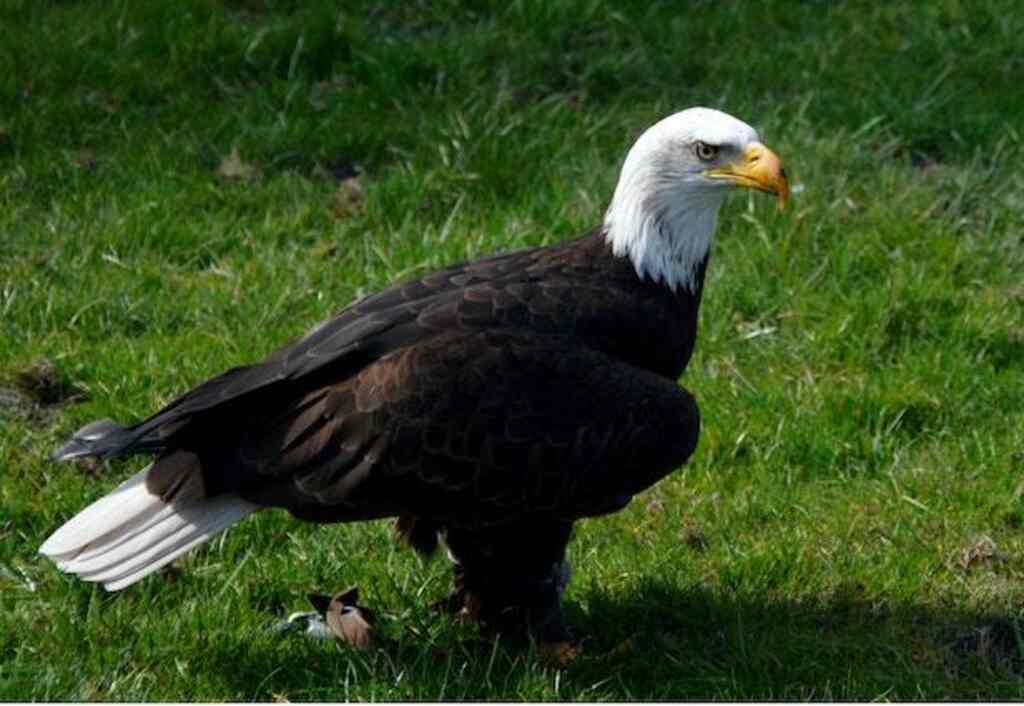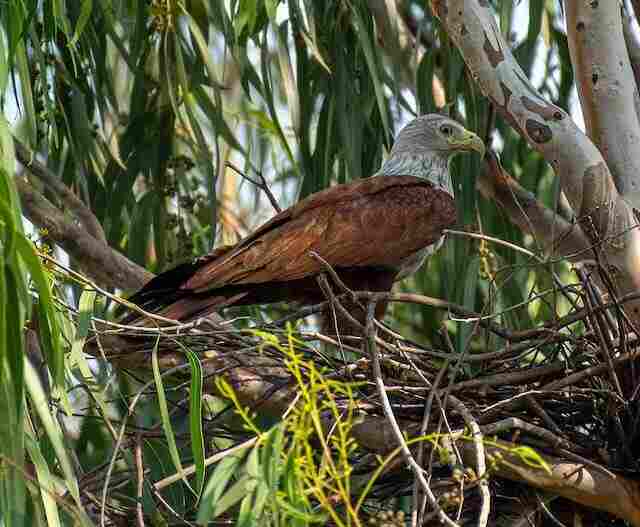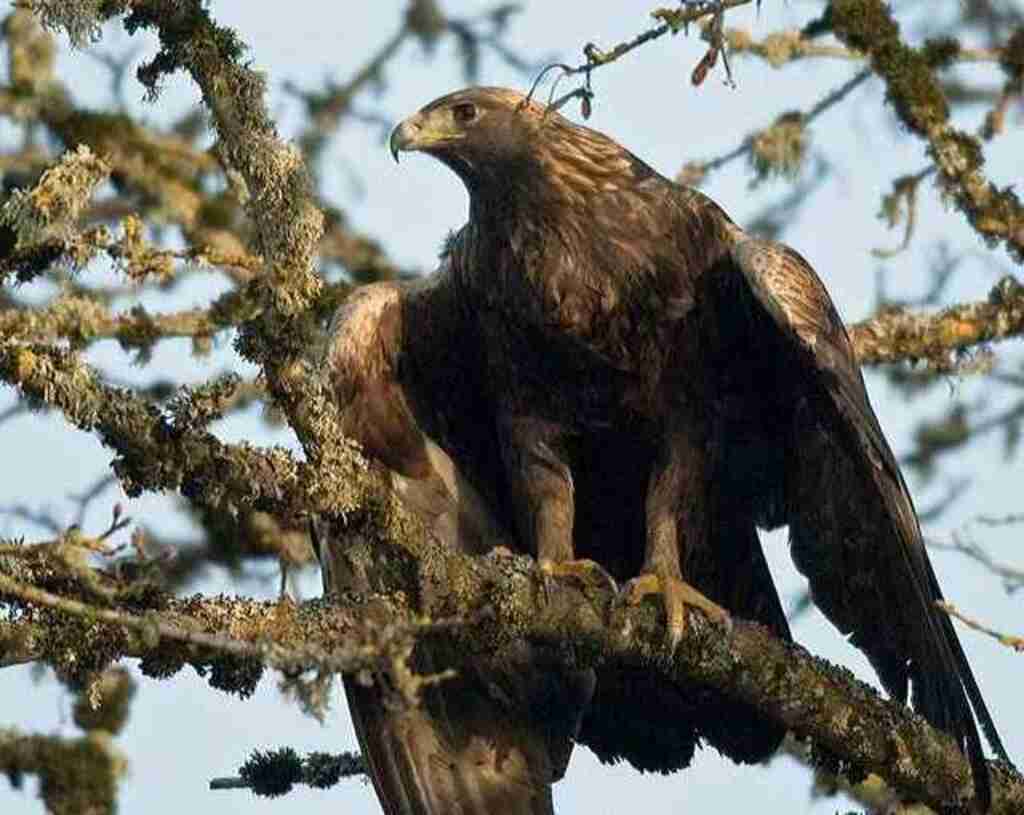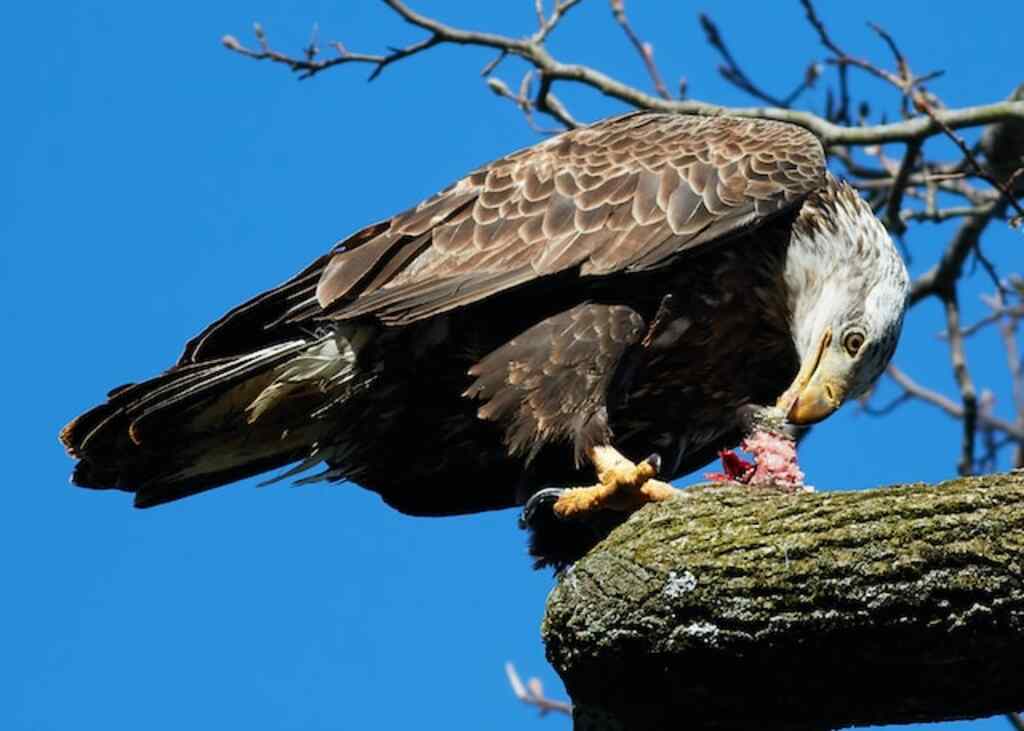Do Eagles Eat Snails? Prepare for a shelled surprise as we dive into the world of these majestic birds of prey and their unlikely appetite for slimy delicacies.
Join us on a whimsical journey filled with curious anecdotes, surprising facts, and the answer to the burning question about eagles and their snail-consuming adventures.
Get ready to be shell-shocked!
Table of Contents
- 1 Key Takeaways
- 2 Do Eagles Eat Snails
- 3 The Diet of Eagles
- 4 Snails as a Food Source
- 5 Observations and Studies
- 6 Eagle-Snail Interactions in the Wild
- 7 Factors Influencing Eagle Diets
- 8 Other Unusual Prey Items
- 9 Importance of Snails in Ecosystems
- 10 Conservation Concerns
- 11 Misconceptions and Myths
- 12 Fascinating Facts about Eagles
- 13 Conclusion: The Truth about Eagles and Snails
- 14 Frequently Asked Questions
- 14.1 How many different species of snails do eagles typically eat?
- 14.2 Are eagles the only bird species known to eat snails?
- 14.3 Can eagles digest the shells of snails?
- 14.4 Do eagles use any specific hunting techniques to catch snails?
- 14.5 Is there a specific time of year when eagles are more likely to eat snails?
- 15 Author
Key Takeaways
- Eagles primarily feed on fish, small mammals, reptiles, and birds, indicating that snails are not a significant part of their diet.
- Snails are low in nutritional value compared to other prey items, but they can still be a potential food source for eagles in times of scarcity.
- Eagles have been observed consuming snails on occasion, suggesting that they are adaptable in their feeding strategies.
- Snail populations directly impact eagle feeding behavior and have ecological roles in their habitats, emphasizing the importance of understanding prey availability and abundance for conservation efforts.

Do Eagles Eat Snails
While eagles primarily feed on fish and small mammals, there have been occasional observations of eagles consuming snails.
However, snails are not a significant or regular part of their diet. These instances may occur when other preferred food sources are scarce, highlighting the adaptability of these majestic birds of prey.
The Diet of Eagles
The diet of eagles consists of a wide variety of prey, including small mammals, fish, reptiles, and birds, but surprisingly, snails are not a significant part of their diet.
This is due to several factors related to snail behavior and the presence of snail predators in the eagles’ environment.
Snails are often found in terrestrial habitats, while eagles primarily hunt in aquatic and aerial environments.
Additionally, snails have protective shells that make them difficult for eagles to consume.
Furthermore, snails are not a preferred food source for eagles as they are low in nutritional value compared to other prey items.
Despite these factors, snails can still be a potential food source for eagles, especially in times of scarcity or when other preferred prey is scarce.
Snails as a Food Source
Snails, being a potential food source, contain a high percentage of protein, making them a nutritious option for certain predators.
When considering the eagle snail interaction, it is interesting to note that while eagles are known for their preference for larger prey items such as fish and small mammals, they have been observed consuming snails on occasion.
Moreover, snails are known to be a delicacy for some eagle species, with reports of eagles actively seeking out areas where snails are abundant.
This preference for snails as a food source highlights the versatility of the eagle’s diet and their ability to adapt to different environments.
Moving forward to the subsequent section about observations and studies, researchers have conducted extensive investigations to understand the factors influencing the eagle snail interaction and its ecological implications.

Observations and Studies
Research on eagle diet has shown that eagles are opportunistic predators and their diet is diverse, consisting mainly of small mammals, birds, fish, and carrion.
However, there is evidence suggesting that eagles also consume snails.
Studies have documented instances of eagles consuming snails, both terrestrial and aquatic species, indicating that these mollusks are a potential food source for eagles.
Behavioral patterns related to snail consumption, such as the use of specific feeding techniques or foraging strategies, are yet to be fully understood and require further investigation.
Research on eagle diet
One fascinating aspect of eagle diet is the diverse range of prey items they consume.
Eagles are opportunistic predators, and their feeding habits vary depending on the availability of food sources in their environment.
Research has shown that eagles consume a wide variety of prey, including mammals, birds, reptiles, and even invertebrates.
While the majority of their diet consists of larger prey such as fish and small mammals, eagles have been observed consuming smaller prey items like snails.
The consumption of snails by eagles is an interesting phenomenon, as it suggests that these birds are capable of adapting their feeding strategies to exploit different food resources.
This evidence of eagles consuming snails highlights their ability to utilize a diverse range of prey items in their diet.
Evidence of eagles consuming snails
An unexpected culinary choice for the eagle’s discerning palate, the consumption of snails sheds light on their ability to adapt and thrive in diverse environments.
Research on eagle diet has revealed interesting patterns of snail consumption.
Although eagles are primarily known for their preference for fish, birds, and small mammals, there is evidence to suggest that they also consume snails.
Analyzing the contents of eagle stomachs and fecal samples, researchers have identified the presence of snail shells and fragments.
This discovery challenges the traditional notion of the eagle’s diet and highlights their opportunistic feeding behavior.
It is intriguing to consider the reasons behind the consumption of snails by eagles, whether it is due to scarcity of other prey or the nutritional value they provide.
Understanding the behavioral patterns related to snail consumption will provide further insights into the adaptability and resourcefulness of these majestic birds.
The behavioral patterns related to the consumption of snails by eagles provide valuable insights into their adaptability and resourcefulness in diverse environments.
Snail hunting techniques vary among eagle species, but typically involve a combination of visual and tactile cues.
Eagles often use their keen eyesight to locate snails in their habitats, such as rocky areas or marshes, where snails are abundant.
Once a snail is spotted, the eagle will use its sharp talons to grasp and extract the snail from its shell. Some eagle species have been observed using tools, such as rocks, to crack open snail shells.
These behavioral patterns highlight the eagles’ ability to exploit a wide range of food sources and adapt their hunting strategies accordingly.
Understanding the ecological role of snails in eagle diets is crucial to comprehending the overall dynamics of these predator-prey interactions in the wild.
Eagle-Snail Interactions in the Wild
Eagle-snail interactions in the wild reveal a fascinating dynamic where the majestic birds of prey, with their razor-sharp talons and keen eyesight, ruthlessly hunt down and devour even the tiniest of snails, showcasing the immense power and adaptability of these incredible predators.
These interactions have significant ecological implications, as they contribute to the regulation of snail populations and influence the overall balance of ecosystems.
Eagles play a crucial role in controlling snail populations, as they are capable of consuming large quantities of snails, thereby preventing their overabundance and potential negative impacts on vegetation and other organisms.
Additionally, the consumption of snails by eagles provides a valuable source of nutrients, particularly calcium, which is essential for their physiological functions and overall health.
The ability of eagles to efficiently hunt and consume snails highlights their adaptability and versatility as predators.
Transitioning into the subsequent section about factors influencing eagle diets, understanding the ecological significance of eagle-snail interactions is crucial in comprehending the broader factors that shape eagle feeding habits.

Factors Influencing Eagle Diets
Geographic location plays a crucial role in shaping the diets of eagles. Different regions offer distinct prey options, resulting in variations in the composition of their diets.
Seasonal variations also impact eagle diets, as certain prey species may become more or less available at different times of the year.
Additionally, prey availability and abundance greatly influence eagle diets, as the abundance of certain prey species can determine their consumption rates and overall diet composition.
Geographic location
Located in various regions around the world, eagles have been observed consuming snails as part of their diet.
Eagles are widely distributed geographically, with different species found in different areas.
This geographic distribution plays a significant role in determining the availability and abundance of snails as a food source for eagles.
In regions where snails are abundant, such as wetland areas or coastal regions, eagles may have a higher likelihood of including snails in their diet.
The ecological significance of this dietary choice lies in the fact that snails are a rich source of calcium, which is important for eggshell formation in birds.
Furthermore, the consumption of snails by eagles may also contribute to the control of snail populations in certain ecosystems.
Moving on to seasonal variations in eagle diets, it is important to explore how the availability of different prey items may influence their feeding behavior.
Seasonal variations
Seasonal changes in prey availability greatly influence the feeding patterns of eagles and shed light on their adaptable nature.
In relation to snail consumption, eagles exhibit intriguing variations throughout the year due to the dynamics of the snail population.
A study conducted over multiple seasons revealed interesting patterns in eagle feeding behavior.
During the spring and summer months, when snails are abundant, eagles consume a significant portion of their diet from this source.
However, as the seasons transition into autumn and winter, snail populations decline, leading to a decrease in their consumption by eagles.
This demonstrates the eagles’ ability to adapt their feeding preferences based on the availability of their preferred prey.
Understanding these seasonal variations is crucial for comprehending the overall diet and foraging strategies of eagles.
The subsequent section will discuss the broader topic of prey availability and abundance, further exploring the factors that influence eagle feeding patterns.
Prey availability and abundance
Prey availability and abundance significantly influence the feeding patterns of eagles and play a crucial role in shaping their dietary preferences.
In the case of snails, their population dynamics directly impact the eagles’ feeding behavior.
Snails are known to have cyclical fluctuations in their numbers, driven by factors such as temperature, humidity, and predation.
Understanding these dynamics is essential for eagles, as they rely on snails as a food source.
Snails also have an ecological role in their habitats, serving as decomposers and participating in nutrient cycling.
The abundance or scarcity of snails can therefore have cascading effects on the entire ecosystem.
By monitoring and studying snail populations, researchers can gain insights into the eagles’ foraging patterns and overall ecosystem health.
This understanding of prey availability and abundance provides valuable information for conservation efforts and management strategies.
Transitioning into the subsequent section about ‘other unusual prey items’, it is clear that eagles have a diverse and adaptable diet beyond snails.
Other Unusual Prey Items
The diet of eagles is often associated with traditional prey items such as fish, small mammals, and birds.
However, eagles have been observed consuming surprising food choices that are not typically associated with their diet.
Examples of unconventional prey for eagles include lizards, turtles, and even carrion.
The potential reasons for consuming such non-typical prey items may include scarcity of their usual food sources, opportunistic feeding behavior, or adapting to changing environmental conditions.
Surprising food choices of eagles
One intriguing example of the surprising food choices of eagles is their consumption of snails, with studies showing that approximately 10% of an eagle’s diet can consist of these small gastropods.
Eagles exhibit diverse feeding behaviors, and their ecological role in the consumption of snails is not well understood.
| Types of Snails | Size | Frequency of Consumption |
|---|---|---|
| Garden Snail | Small | Rarely |
| Roman Snail | Medium | Occasionally |
| Giant African Snail | Large | Rarely |
| Land Snail | Varies | Infrequently |
| Pond Snail | Small to | Rarely |
| Medium |
Note: While eagles have been observed consuming snails on occasion, it is important to note that their diet primarily consists of fish, small mammals, and birds.
Snail consumption by eagles is not a significant or regular part of their feeding behavior.
This information provides insight into the dietary preferences of eagles and their potential impact on snail populations.
Understanding the factors influencing eagle behavior and their interactions with snails can contribute to a more comprehensive understanding of ecosystems.
Examples of unconventional prey, such as insects and reptiles, further illustrate the adaptability and versatility of eagles in their foraging strategies.
Examples of unconventional prey
Eagles, known for their impressive hunting abilities and keen eyesight, often exhibit surprising food choices.
While most people associate eagles with hunting small mammals and fish, there are instances where they display unconventional prey preferences.
These examples of uncommon prey highlight the diverse feeding behavior of these majestic birds.
For instance, some eagles have been observed consuming snails, a food source that is not typically associated with their diet.
This intriguing behavior raises questions about the ecological interactions between eagles and snails. It suggests that eagles may possess a remarkable adaptability and flexibility in their feeding habits.
Understanding the factors that drive eagles to consume non-typical prey can provide valuable insights into their foraging strategies and overall ecological role.
Exploring potential reasons for consuming such prey will shed light on the fascinating adaptations and behaviors of these magnificent birds.
Potential reasons for consuming non-typical prey
An examination of the potential reasons for eagles consuming non-typical prey reveals the complex ecological dynamics at play in their feeding behavior.
Eagles, typically known for their ability to catch and consume larger prey such as fish and mammals, have been observed consuming snails in certain instances. This behavior may be attributed to several factors:
- Scarcity of traditional prey: In areas where the availability of preferred prey is limited, eagles may resort to consuming snails as a survival strategy.
- Nutritional value: Snails can provide a source of essential nutrients, such as calcium, which may be lacking in the eagles’ diet.
- Opportunistic feeding: Eagles are known to be opportunistic predators, and consuming snails may simply be a result of encountering them in their habitat.
- Environmental factors: Environmental changes, such as habitat destruction or pollution, may alter the availability of preferred prey and force eagles to adapt their feeding habits.
- Ecological implications: Snail predation by eagles can have both positive and negative effects on ecosystems, influencing population dynamics and potentially altering food webs.
Understanding the factors driving eagles to consume non-typical prey like snails provides valuable insights into the interconnectedness of species within ecosystems.
Moving forward, it is crucial to explore the importance of snails in ecosystems and their role in supporting biodiversity.
Importance of Snails in Ecosystems
Snails are often overlooked, but they serve as important indicators of ecosystem conditions, including water quality and soil health.
They are sensitive to changes in their environment and can provide valuable insight into the overall health of an ecosystem.
Snails are also an important food source for a variety of organisms, such as birds, reptiles, and mammals. Their consumption by these predators helps to regulate snail populations and prevent overgrowth.
Additionally, snails contribute to nutrient cycling by breaking down organic matter and recycling nutrients back into the ecosystem.
Understanding the importance of snails in ecosystems is essential for snail conservation and maintaining the ecological balance.
Transitioning to the next section, conservation concerns arise due to the potential threats faced by snail populations.

Conservation Concerns
Conservation concerns for eagles primarily revolve around threats to their populations. These threats include habitat loss, which not only impacts eagles directly but also affects their prey.
As habitat is destroyed, the availability of suitable nesting sites and food sources for eagles diminishes.
To address these concerns, conservation efforts focus on protecting both eagles and their food sources through measures such as habitat preservation, land management practices, and reducing human disturbances in critical eagle habitats.
Threats to eagle populations
One significant factor affecting eagle populations is the presence of various threats. These threats have led to a decline in eagle populations, resulting in significant ecological consequences.
Some of the major threats to eagle populations include:
- Habitat loss: The destruction of natural habitats due to human activities, such as deforestation and urbanization, reduces the availability of suitable nesting sites and prey for eagles.
- Pollution: Chemical pollutants, such as pesticides and heavy metals, can accumulate in the bodies of eagles and have detrimental effects on their reproductive success and overall health.
- Poaching and illegal trade: Eagles are often targeted for their feathers, eggs, and body parts, which are highly valued in certain cultures and markets.
- Collisions with human-made structures: Eagles are at risk of colliding with power lines, wind turbines, and vehicles, leading to injuries and mortality.
- Climate change: Alterations in temperature and precipitation patterns can impact the availability of food sources and nesting habitats for eagles.
These threats pose a significant challenge to the conservation of eagle populations and highlight the urgent need for effective conservation measures.
Understanding the impact of habitat loss on eagles and their prey is crucial in developing strategies to mitigate these threats and ensure the long-term survival of these majestic birds.
Impact of habitat loss on eagles and their prey
Habitat loss poses a significant threat to eagle populations, affecting both the eagles themselves and their prey.
The destruction of natural habitats, such as forests and wetlands, results in a loss of suitable nesting sites for eagles and diminishes the availability of prey.
Eagles rely on a diverse range of prey species to maintain their ecological balance within their habitats, and habitat loss disrupts this delicate equilibrium.
As their habitats shrink, eagles are forced to compete for limited resources, which can lead to reduced breeding success and population decline.
Furthermore, habitat loss also impacts the availability and abundance of prey species, potentially destabilizing entire ecosystems.
To understand and address the consequences of habitat loss on eagles and their prey, conservation efforts must focus on protecting and restoring critical habitats, ensuring the long-term survival of these magnificent birds and the ecological balance they maintain.
Conservation efforts to protect eagles and their food sources
To ensure the preservation of eagle populations and their prey, efforts must be directed towards safeguarding and enhancing the availability of suitable nesting sites and diverse food sources.
Conservation strategies and wildlife management play a crucial role in achieving this goal. Here are three key approaches that are commonly employed:
- Habitat restoration: This involves restoring degraded habitats to their original state, providing eagles with suitable nesting sites and ensuring the availability of diverse food sources.
- Conservation education: Raising awareness among the public about the importance of eagles and their prey is essential. Educating communities about the impact of habitat loss and the need for conservation measures can help garner support for eagle protection efforts.
- Monitoring and research: Regular monitoring of eagle populations and their prey can provide valuable insights into their behavior, population dynamics, and potential threats. This information can guide effective conservation strategies and wildlife management efforts.
By implementing these conservation strategies, we can ensure the long-term survival of eagles and their food sources.
Transitioning into the subsequent section about ‘misconceptions and myths,’ it is important to address common misconceptions surrounding eagle conservation and shed light on the truth.

Misconceptions and Myths
Contrary to popular belief, there are no scientific studies or evidence to support the claim that eagles consume snails as part of their diet.
While eagles are known to be opportunistic predators and have a diverse diet, including fish, small mammals, and birds, snails are not a common or conventional food source for them.
This misconception may arise from the fact that eagles are often observed scavenging for carrion, and snails could potentially be found on decomposing animal carcasses.
However, it is important to note that this behavior does not indicate that eagles actively seek out snails as a food source.
In fact, eagles primarily rely on larger prey items that provide them with the necessary nutrients and energy. Moving forward, let’s explore some fascinating facts about eagles and their remarkable abilities.
Fascinating Facts about Eagles
Renowned for their exceptional vision, eagles possess a visual acuity that is up to four times greater than that of humans, allowing them to spot prey from great distances.
This remarkable eyesight is crucial for their hunting techniques.
Eagles employ various hunting strategies, such as soaring high above their prey and swooping down at incredible speeds to catch it off guard.
They also have sharp talons and strong beaks, which enable them to capture and kill their prey swiftly.
In addition to their hunting prowess, eagles have fascinating nesting habits. They build large nests called eyries, typically located in tall trees or on cliffs.
These nests are carefully constructed using branches and twigs and can be used for several years.
Transitioning into the subsequent section, it is important to examine the truth about eagles and snails.
Conclusion: The Truth about Eagles and Snails
In conclusion, a closer examination of the relationship between eagles and snails reveals an intriguing dynamic that highlights the diverse and adaptable nature of these majestic birds.
Eagle snail interactions are not a commonly studied phenomenon, but recent research has shed some light on this subject.
It has been observed that eagles do consume snails, although it is not a significant part of their diet. Snail consumption patterns vary depending on the species of eagle and the availability of other food sources.
Eagles primarily consume snails when other prey options are limited, such as during the winter months. They use their sharp beaks and powerful talons to extract the snail from its shell before consuming it.
Further research is needed to fully understand the extent of eagle snail interactions and their ecological implications.

Frequently Asked Questions
How many different species of snails do eagles typically eat?
Eagles consume various species of snails as part of their foraging behavior. The impact of snail consumption on eagle diet diversity is significant, as it adds to the range of prey they consume and contributes to their overall diet variety.
Are eagles the only bird species known to eat snails?
Snail consumption by other bird species is documented, although eagles are known to have a particular affinity for snails. The nutritional benefits of snails in an eagle’s diet include high protein content and essential minerals.
Can eagles digest the shells of snails?
Eagles have a diverse diet which includes snails. While they can consume the soft body of snails, their ability to digest the shells is limited due to the lack of specialized digestive enzymes.
Do eagles use any specific hunting techniques to catch snails?
Eagles do not use specific hunting techniques to catch snails. Their hunting techniques are primarily focused on capturing larger prey. Snail consumption patterns by eagles are not well-documented in scientific literature.
Is there a specific time of year when eagles are more likely to eat snails?
The impact of climate change on snail populations can affect the availability of snails as a food source for eagles. Additionally, the role of snails in the diet of different eagle species varies across geographical regions.




